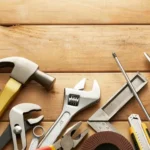DIY (Do It Yourself) projects can be both rewarding and cost-effective. However, selecting the right tool for the job is crucial to ensure efficiency, safety, and quality results.
Whether you’re a seasoned DIYer or a beginner, this guide will help you understand how to choose the right tool for any project.
Why Choosing the Right Tool Matters?
Selecting the appropriate tool enhances precision, reduces work time, and ensures safety.
Using the wrong tool can lead to damage, poor craftsmanship, and even injuries. Below are some key benefits of using the right tools:
- Efficiency: The right tool makes the job easier and faster.
- Safety: Minimizes the risk of accidents.
- Precision: Ensures accuracy in measurements and cuts.
- Durability: Reduces wear and tear on materials and tools.
- Cost-effectiveness: Prevents waste and unnecessary expenses.
- Professional Results: Even DIYers can achieve professional-grade work with the right tools.
ALSO READ: How to Stream Your Gameplay on Twitch or YouTube?
Factors to Consider When Choosing a Tool

Before selecting a tool for your DIY project, consider the following factors:
Type of Project
Different projects require different tools. For instance:
- Woodworking: Requires saws, chisels, drills, and clamps.
- Plumbing: Needs wrenches, pipe cutters, and sealants.
- Electrical Work: Demands wire strippers, voltage testers, and screwdrivers.
- Painting & Finishing: Calls for brushes, rollers, and sanders.
- Masonry & Concrete Work: Needs trowels, concrete mixers, and rebar cutters.
- Landscaping & Gardening: Requires shovels, shears, trimmers, and cultivators.
Material Being Worked On
The hardness, thickness, and composition of the material affect tool choice. For example:
- Metal: Requires metal-cutting saws and grinders.
- Wood: Needs chisels, saws, and sanders.
- Concrete: Requires heavy-duty drills and hammers.
- Glass & Tile: Needs glass cutters, tile saws, and polishing tools.
- Plastic: Requires hot knives, rotary tools, and specialty cutters.
Manual vs. Power Tools
- Manual Tools: More affordable, ideal for precision work and small projects.
- Power Tools: Faster, efficient, and suitable for larger projects, but often require power sources and maintenance.
Ergonomics and Comfort
Select tools that are comfortable to hold and easy to use for long periods. Features to look for include:
- Rubberized handles for better grip.
- Lightweight materials to reduce hand fatigue.
- Vibration control for power tools to enhance comfort.
Budget and Quality
Invest in quality tools to ensure durability and better results. Cheaper tools may work for occasional use, but premium tools often last longer and perform better.
Essential DIY Tools and Their Uses
| Tool | Type | Primary Use |
|---|---|---|
| Hammer | Manual | Driving nails, breaking materials |
| Screwdriver Set | Manual | Tightening and loosening screws |
| Cordless Drill | Power | Drilling holes, assembling furniture |
| Saw (Hand or Electric) | Manual/Power | Cutting wood, plastic, or metal |
| Measuring Tape | Manual | Taking accurate measurements |
| Wrench Set | Manual | Turning bolts and nuts |
| Pliers | Manual | Gripping, cutting, and bending wires |
| Utility Knife | Manual | Cutting various materials |
| Level | Manual | Ensuring straight alignments |
| Sander | Power | Smoothing surfaces |
| Jigsaw | Power | Cutting curves and intricate shapes |
| Angle Grinder | Power | Cutting, grinding, and polishing metal or stone |
| Clamps | Manual | Holding materials together while working |
| Multimeter | Manual | Measuring electrical currents |
ALSO READ: How to Set Up a Smart Home System in Simple Steps?
Specialized Tools for Specific DIY Projects

Home Renovation
- Nail Gun: Speeds up nailing tasks.
- Stud Finder: Locates studs for secure installations.
- Tile Cutter: Used for precision tile cuts.
- Caulking Gun: Seals gaps in bathrooms and windows.
- Oscillating Multi-Tool: Versatile for cutting, sanding, and scraping.
Furniture Making & Woodworking
- Router: Shapes wood edges.
- Clamps: Holds materials in place.
- Planer: Levels and smoothens wood surfaces.
- Dovetail Jig: Assists in creating precise joints.
- Wood Lathe: For carving symmetrical wooden objects.
Electrical Work
- Multimeter: Measures electrical current.
- Wire Cutter: Cuts wires cleanly.
- Voltage Tester: Checks for live wires.
- Cable Stripper: Removes insulation from electrical wires.
- Soldering Iron: Essential for circuit board repairs.
Plumbing Repairs
- Pipe Wrench: Grips and turns pipes.
- Teflon Tape: Seals pipe threads.
- Plunger: Unclogs drains and toilets.
- Pipe Cutter: Cuts copper and plastic pipes cleanly.
- Drain Snake: Clears deep clogs.
How to Maintain Your Tools?
Keeping your tools in top condition prolongs their lifespan and ensures they work efficiently.
- Clean After Use: Wipe down tools to remove dirt and rust.
- Store Properly: Keep tools in dry, organized spaces.
- Sharpen Blades: Maintain sharp edges on cutting tools.
- Lubricate Moving Parts: Prevents rust and ensures smooth operation.
- Check for Wear & Tear: Replace damaged parts before they cause accidents.
- Keep Power Tools Charged & Batteries Stored Properly.
Common Mistakes to Avoid

- Using the Wrong Tool: Can damage materials and be unsafe.
- Ignoring Safety Gear: Always wear gloves, goggles, and masks.
- Skipping Maintenance: Leads to dull blades and malfunctioning tools.
- Not Measuring Accurately: Leads to wasted materials and improper fits.
- Overlooking Manufacturer Instructions: Reduces tool effectiveness and safety.
ALSO READ: How to Use Cloud Storage Effectively for Personal and Business Use?
Conclusion
Choosing the right tool for a DIY project is crucial for achieving the best results. By considering the type of project, material, ergonomics, and quality, you can ensure efficiency and safety.
Investing in good-quality tools and maintaining them properly will make your DIY endeavors more successful and enjoyable.
Whether you’re renovating a home, crafting furniture, or fixing plumbing, having the right tools at your disposal will ensure success and long-lasting results.







